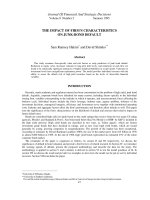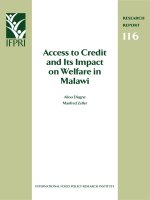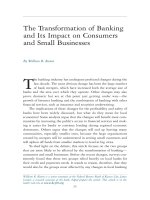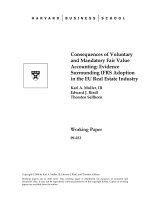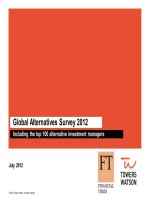THE EU ALTERNATIVE INVESTMENT FUND MANAGERS DIRECTIVE: IMPACT ON NON-EU FUND MANAGERS ppt
Bạn đang xem bản rút gọn của tài liệu. Xem và tải ngay bản đầy đủ của tài liệu tại đây (129.55 KB, 9 trang )
B
EIJING | BRUSSELS | LONDON | NEW YORK | SAN DIEGO | SAN FRANCISCO | SEOUL | SHANGHAI |SILICON VALLEY | WASHINGTON
www.cov.com
ADVISORY | Funds and Investments
22 January, 2013
THE EU ALTERNATIVE INVESTMENT FUND MANAGERS
DIRECTIVE: IMPACT ON NON-EU FUND MANAGERS
WHAT IS THE ALTERNATIVE INVESTMENT FUND MANAGERS DIRECTIVE?
The Alternative Investment Fund Managers Directive (the “
Directive
”) aims to create a
harmonised European regulatory framework for managers of alternative investment funds (“
AIF
”).
In broad terms, the Directive regulates the management and marketing of AIF where the activity
takes place in the European Union or the AIF concerned are established in the European Union
(the “
EU
”).
AIF Definition
An AIF is broadly defined as a collective investment undertaking
(irrespective of its legal
structure):
• that raises capital from a number of investors;
•
with a view to investing it in accordance with a defined investment policy for the benefit of
those investors; and
• is not required to obtain authorisation under the Undertakings for Collective Investment in
Transferable Securities (“
UCITS
”) Directive (the
EU directive which establishes a single
market for open-
ended retail investment funds to ensure a high level of protection for retail
investors across the EEA).
Although the Directive aims to regulate managers of alternative investment funds, the broad
definitions given to “alternative investment fund manager” (“
AIFM
”) and “AIF” have the effect of
bringing within the Directive’s scope not only managers of hedge funds and private equity funds
but also managers of all types of investment fund that are not UCITS, including real estate funds,
commodity funds and infrastructure funds and funds of funds.
The Directive entered into force on 21 July 2011 and must be implemented by EU member states
by 22 July 2013.
The Directive is expected to be implemented in the EEA states which are not also EU member
states - i.e. Norway, Lichtenstein and Iceland. Accordingly, references in this note to the EU
should be read as references to the EEA.
COVINGTON & BURLING LLP
C&B
2
THE REQUIREMENT FOR AUTHORISATION
The Directive requires that AIFMs falling within its scope be authorised and subject to supervision
by the regulator in their home jurisdiction. The Directive also introduces a European "passport"
under which authorised AIFMs are entitled, subject to compliance with certain requirements, to
manage AIF in other EU member states and market AIFs to professional investors throughout the
EU.
Exemptions
The Directive provides for exemptions for certain types of entity which might otherwise fall to be
treated as an AIFM. These include: certain holding companies, institutions for occupational
retirement provision and their managers and investment managers (provided that they do not
manage AIF), employee participation and savings schemes, securitisation special purpose
entities and joint ventures. In addition, AIFMs that manage AIF whose only investors are
companies in the same group as the AIFM are also exempt.
Further, there is a size threshold exemption for AIFMs based on the level of assets under
management. The Directive applies only very limited requirements to AIFM which manage AIF
whose assets under management (across all managed AIF) do not exceed €
100 million in
aggregate or, if the AIF under management are unleveraged and do not offer redemption rights
exercisable during the initial 5 years of the fund’s life, €500 million in aggregate.
The limited requirements for AIFMs under the threshold are a requirement to register with a
regulator in the home member state of the AIFM and a requirement to provide to the regulator
information on the investment strategies of the AIF under management and periodic
information on the main instruments traded, principal exposures and concentrations. These are
however minimum requirements. It is open to member states to impose additional or stricter
requirements. The UK is currently proposing not to impose additional or stricter requirements
except in the case of AIFM managing certain categories of UK authorised funds.
APPLICATION TO NON-EU FUND MANAGERS
In addition to applying to AIFMs established in the EU, the Directive applies to AIFMs which are
established in countries outside the EU (“
non-EU AIFMs
”) and which either:
manage AIFs established in the EU (“
EU AIF
”); or
market any AIFs (whether or not established in the EU) to investors in the EU.
The European Commission has acknowledged its lack of experience in regulating firms
established in jurisdictions outside the EU and the potential uncertainties in applying the
authorisation and EU-wide passport provisions of the Directive to non-EU AIFMs. Therefore, the
Directive provides that its application to non-EU managers carrying on the management and/or
marketing activities described above will be subject to a review to be undertaken not later than
July 2015. Pending the outcome of that review, non-EU managers marketing AIFs to investors in
the EU will be subject to certain minimum mandatory requirements which will need to be met
both in relation to the marketing and on a continuing basis.
The outcome of the review will determine whether non-EU managers carrying on the
management and/or marketing activities described above will be brought within the full scope of
the Directive. It is anticipated that this is likely to be the case from some point in late 2015.
COVINGTON & BURLING LLP
C&B
3
The following set of timelines summarise how the Directive will apply to non-EU AIFMs over the
next few years:
Prior to 22 July 2013
Non-EU AIFMs may continue to manage EU AIFs and market both EU
and non-EU AIFs
managed by them in EU member states in
compliance with currently applicable local laws
in those member
states.
22 July 2013 to 2015
Non-EU AIFMs may continue to manage EU AIFs and market both EU
and non-
EU AIFs managed by them in EU member states in
compliance with applicable local laws
in those member states.
However, in relation to any marketing activity, member states will be
required to impose certain additional requirements (see “Mandatory
Requirements for non-
EU AIFM marketing AIF to EU Investors”
below).
2015 to 2018
Assuming the review to be undertaken by July 2015 results in the
Directive’s authorisation regime being applied to non-EU AIFMs:
(i) non-EU AIFMs managing EU AIFs will, subject to any exemption
being available, be required to be authorised under the Directive
which will mean submission to the full Directive regime (which will
carry an entitlement to market EU and non-EU AIFs managed by the
non-EU AIFM to EU investors, subject to applicable conditions being
met);
(ii) non-EU AIFMs marketing non-EU AIFs managed by them to EU
investors (but not managing any EU AIF) may either:
•
become authorised under the Directive on a voluntary basis
in order to take advantage of the EU marketing passport; or
• remain unauthorised and market those non-
EU AIFs in
compliance with applicable local laws
in the relevant
member states, which will reflect the additional mandatory
requirements in relation to marketing activity referred to
above (see “Mandatory Requirements for non-
EU AIFM
marketing AIF to EU Investors” below).
2018 onwards
Subject to a review on the functioning of the passport under the
Directive (to be undertaken 3 years after the Directive’s
authorisation regime is applied to non-EU AIFMs), the ability for non-
EU AIFMs to market their AIFs to EU investors in compliance with
individual member state national laws
without being authorised
under the Directive is expected to be phased out. Non-EU AIFMs
marketing non-EU AIFs managed by them to EU investors will be
required to be authorised under the Directive which will mean
submission to the full Directive regime (and which will carry an
entitlement to market the AIFs to EU investors, subject to applicable
conditions being met).
COVINGTON & BURLING LLP
C&B
4
MANDATORY REQUIREMENTS FOR NON-EU AIFMS MARKETING AIF TO EU INVESTORS
From 22 July 2013, EU member states will be required to impose the following requirements in
relation to any marketing to professional (i.e. non-retail) investors in their jurisdictions by non-EU
AIFMs of AIFs (whether EU or non-EU) managed by them. These requirements will apply in
addition to any local law requirements in member states. It should be noted that, as is the case
currently, there is no requirement for member states to permit marketing activity by non-EU
AIFMs; this is at the discretion of individual member states. In contrast, non-EU AIFM which
become authorised under the Directive in due course (if this becomes possible, it will not be until
2015 at the earliest) will have an entitlement to market AIF managed by them on a pan-EU basis,
subject to meeting certain specified conditions. The requirements noted below (or substantially
similar requirements) will also apply to an authorised non-EU AIFM in connection with any
marketing activity.
The requirements applying from 22 July 2013 are as follows:
(a) Existence of Cooperation arrangements/no connection with NCCTs
A cooperation arrangement for the purpose of systemic risk oversight in line with international
standards must be in place (i) where the AIF being marketed is a non-EU AIF, between the
regulator in the member state in which the AIF will be marketed and the supervisory authorities in
both the non-EU AIFM’s jurisdiction of establishment and the supervisory authority in the
jurisdiction in which the AIF is established, or (ii) where the AIF being marketed is an EU AIF,
between the regulators in both the member state in which the AIF will be marketed and the
member state in which the AIF is established and the supervisory authority in the non-EU AIFM’s
jurisdiction of establishment. Marketing in the EU will be prohibited in circumstances where the
country in which either the non-EU AIFM is established or the jurisdiction in which the AIF to be
marketed is established (if it is a non-EU AIF) is on the list of Non-Cooperative Country and
Territories published by the Financial Action Task Force.
The establishment of co-operation arrangements between EU member states and non-EU
jurisdictions is being handled on a co-ordinated basis by the European Securities and Markets
Authority (ESMA) on behalf of EU member states. To date, an agreement has been entered into
between the Swiss Financial Market Supervisory Authority (FINMA) and the EU securities
regulators. No agreements with other non-EU supervisory authorities have yet been put in place
and the timeframe for concluding agreements with authorities in other jurisdictions is uncertain.
(b) Compliance with Transparency requirements
Disclosures to investors: for each AIF marketed in the EU, non-EU AIFMs will be required to
make available to the EU investors concerned before they invest prescribed information
relating, amongst other things, to: the AIF’s objectives and investment strategy and
restrictions, the types of assets to be invested in, the investment techniques to be employed
and associated risks, historical performance (where available), the use of leverage and
associated risks, collateral and asset re-use arrangements, information relating to the AIFM,
depositary, prime broker and other service providers (and any delegation arrangements), the
valuation procedure and methodology, liquidity risk management and any preferential
treatment given to any investors.
Any subsequent material change to that information would also need to be disclosed.
Further, a continuing obligation to disclose certain information on a periodic basis (including
information relating to illiquid assets, liquidity management, leverage employed, risk profile
and risk management) would apply. Detailed rules made by the EU Commission will apply to
the initial and periodic disclosures to be made.
COVINGTON & BURLING LLP
C&B
5
Preparation of Annual Reports: for each AIF marketed in the EU, non-EU AIFMs will be
required to prepare an annual report for each financial year of the AIF and make it available
not later than 6 months after the end of the financial year to the regulator in each member
state in which the AIF was marketed. In addition the annual report would need to be made
available on request to EU investors in the AIF. The mandatory content requirements for such
annual reports include, amongst other information, the total amount of remuneration for the
financial year (split into fixed and variable remuneration) paid by the AIFM to its staff, the
number of beneficiaries, and, where relevant, the carried interest paid by the AIF as well as
the aggregate amount of remuneration broken down by senior management and members of
staff of the AIFM whose actions have a material impact on the risk profile of the AIF. The
preparation of annual reports will be subject to detailed rules made by the EU Commission.
The accounting information in the report will need to be prepared in accordance with
accounting standards of the jurisdiction in which the AIF is established and the accounting
rules laid down in the AIF rules or constitution. The report will need to be audited in
accordance with applicable EU auditing standards if the AIF is established in the EU or, if it is
not and if permitted by the member states into which the AIF is marketed (which is optional),
in accordance with international auditing standards in force in the jurisdiction in which the
AIF is established.
Periodic filings with regulators: for each AIF marketed in the EU, non-EU AIFMs will be
required periodically to provide to the regulator in each EU jurisdiction in which the AIF is
marketed certain information relating to the principal markets and instruments in which the
non-EU AIFM trades on behalf of the AIF, assets which are illiquid, the risk profile of the AIF
and the risk management systems employed, the results of liquidity stress tests and
investment risk stress tests and information in relation to leverage (where substantial
leverage is employed). The information to be provided will be subject to detailed rules made
by the EU Commission.
(c) Compliance with Restrictions on “asset stripping”
Non-EU AIFMs marketing AIF to EU investors will be required to comply with the Directive’s
restrictions in relation to the prevention of “asset stripping”. Where the marketed AIF acquires
(either itself or acting together with other AIFs managed by its AIFM or with AIFs managed by third
party AIFMs):
control (i.e. 50% or more of the voting rights) of an EU company which is not admitted to
trading on an EU regulated market (and which is not a small or medium sized enterprise
1
or a
real estate SPV); or
control
2
of an EU company which is admitted to trading on an EU regulated market;
The AIFM must not, for a period of 24 months following the acquisition of control, facilitate,
support (including by voting in favour of) or instruct, and must use its best efforts to prevent, any
distribution, capital reduction, share redemption and/or acquisition of own shares by the
company funded, broadly speaking, otherwise than out of the company’s distributable profits and
reserves.
1
Micro, small and medium-sized enterprises are enterprises which employ fewer than 250 persons and
which have an annual turnover not exceeding EUR 50 million, and/or an annual balance sheet total not
exceeding EUR 43 million.
2
Control in relation to a traded company is the percentage of voting rights determined by the member
state in which the company has its registered office for the purposes of the EU Takeover Directive. In the
UK it is 30%.
COVINGTON & BURLING LLP
C&B
6
(d) Compliance with Notification of Holdings requirements
Investment in EU unlisted companies
Non-EU AIFMs marketing AIF to EU investors will be required to comply with the Directive’s
restrictions on the notification of holdings in EU companies which are not admitted to trading on
an EU regulated market (and which are not small or medium sized enterprises or real estate
SPVs). These are of particular relevance to private equity funds investing into the EU. The AIFM
will be required:
to notify the regulator in each member state in which the AIF is marketed of holdings of the
marketed AIF of voting shares in such companies that reach, exceed or fall below certain
specified thresholds (10%, 20%, 30%, 50% and 75%);
where the marketed AIF acquires (either itself or acting together with other AIFs managed by
its AIFM or with AIFs managed by third party AIFMs) 50% or more of the voting rights of any
such company, to notify the company (and, via the company, its employees), its shareholders
(to the extent that these can be identified by the AIFM) and the regulator in each member
state in which the AIF is marketed of:
1. the acquisition of control, including the level of voting rights acquired and the conditions
under which control was acquired (including the identity of the shareholders involved,
persons entitled to exercise votes on their behalf and, if applicable, the chain of
ownership through which voting rights are held) and the date on which control was
acquired;
2. the identity of the AIFM and the policy for preventing and managing conflicts of interest, in
particular between the AIFM, the AIF and the company (including information about the
specific safeguards established to ensure that any agreement between the AIFM and/or
the AIF and the company is concluded at arm’s length) and the policy for external and
internal communication relating to the company in particular as regards employees; and
3. its intentions with regard to the company’s future business and any likely repercussions
on employment (including any material change in employment conditions) (note this
information need not be notified to the regulators in member states where the AIF was
marketed).
where the marketed AIF acquires (either itself or acting together with other AIFs managed by
its AIFM or with AIFs managed by third party AIFMs) 50% or more of the voting rights of any
such company, to either include certain specified information in the annual report of such AIF
or to use best efforts to ensure that such information is included in the company’s annual
report and is made available to the company’s employees. The specified information
includes a fair review of the development of the company’s business over the period covered
by the report and an indication of the company’s likely future development.
Investment in EU traded companies
Where an AIF marketed by a non-EU AIFM to EU investors acquires control
3
of an EU company
which is admitted to trading on an EU regulated market, the AIFM is required to notify the
information described in (d)(ii)2. above to the company (and, via the company, its employees), its
shareholders (to the extent that these can be identified by the AIFM) and the regulator in each
member state in which the AIF is marketed.
3
Control in relation to a traded company is the percentage of voting rights determined by the member
state in which the company has its registered office for the purposes of the EU Takeover Directive. In the
UK it is 30%.
COVINGTON & BURLING LLP
C&B
7
It should be noted that the Directive permits individual member states to impose stricter rules on
non-EU AIFMs in respect of the marketing of AIFs to investors in their territories.
WHAT DOES MARKETING COVER?
For the purposes of the Directive marketing extends to the direct or indirect offering or placing of
units or shares in an AIF at the initiative of, or on behalf of, its AIFM. Preliminary marketing which
falls short of an offer or marketing is not within the ambit of the Directive and, thus, is not
regulated by it. Accordingly, engaging in preliminary marketing should not invoke the need to
comply with the mandatory requirements described above. These would need to be complied
with only prior to an offer or placing commencing. Preliminary marketing may of course be
regulated at a national level in individual member states (as is the case in the UK).
Non-EU AIFMs marketing AIF to EU investors will, from 22 July 2013, be subject to the mandatory
requirements described above whether the marketing is undertaken directly by the AIFM or
indirectly through an intermediary on behalf of the AIFM. The Directive imposes an obligation on
intermediaries acting on behalf of AIFMs not to offer or place units or shares in AIFs to or with EU
investors unless the marketing requirements of the Directive have been met.
The Directive does not regulate or restrict investors from investing in AIFs on their own initiative.
Accordingly, the mandatory requirements described above should not apply to non-EU AIFMs
which admit investors to their managed funds in circumstances where those investors have
approached the AIFM of their own accord without being solicited by the AIFM. It is not clear
though whether demonstrating that an investment has been achieved by way of a ‘reverse
solicitation’ will be straightforward. It remains to be seen what approach to this issue will be
taken by member state regulators.
MARKETING: PRACTICAL ISSUES
A number of practical issues should be noted by non-EU managers:
as indicated above, EU member states will not be obliged, after 22 July 2013, to allow
marketing in their jurisdictions by non-EU AIFM. This will remain optional, as it is now.
Moreover, member states may seek to impose stricter marketing requirements and
conditions than those mandated by the Directive. There is a concern that a number of
member states may use the Directive as an opportunity to tighten up, or even remove, their
private placement exemptions. Some member states (for instance Germany) appear to be
heading in this direction;
this will mean that, notwithstanding the marketing requirements laid down in the Directive, it
will be necessary to take local advice in relevant EU member states before proceeding with
(or continuing) an EU offering or placement after 22 July 2013. Member States may not
finalise or adopt their local requirements until shortly before that date and local registration
or filing with a regulator may well be required before commencing marketing. It is possible
that this may lead to delays in being able to commence (or continue) offering and marketing
activity after 22 July 2013;
there is uncertainty as to when the co-operation arrangements required in connection with
marketing into the EU by non-EU AIFM will be put in place. It may be that arrangements will
not be in place as at 22 July 2013 in relation to key non-EU jurisdictions. This would prevent
any offering or placing after that date by AIFM based in jurisdictions with which arrangements
are not in place or by AIFM undertaking an offering or placing in the EU of a non-EU AIF
established in a jurisdiction with which no arrangements are in place (even if arrangements
are in place with the jurisdiction in which the AIFM is based). This would have particular
relevance in the context of an offering or placing in the EU which has commenced before 22
July 2013 but which has not finally closed by that date;
COVINGTON & BURLING LLP
C&B
8
if the necessary co-operation agreements for a marketing to EU investors are in place, in
order to proceed with (or continue) an offering or placement after 22 July 2013, a non-EU
AIFM will need to have a disclosure document prepared to give to EU investors and have
developed the appropriate systems and controls to ensure that it can comply with the
required periodic disclosure and annual report requirements, filing requirements and, if
marketing an AIF which invests into the EU and may acquire controlling interests or interests
above the notification threshold, with the notification requirements and anti-asset stripping
restrictions;
it may be prudent for non-EU managers contemplating marketing into the EU to consider
whether the mandated disclosure requirements would give rise to any asymmetry in relation
to information given to EU investors and that given to non-EU investors in the marketed AIF
and whether this may drive any need to make additional/broader disclosures to non-EU
investors;
it will be prudent for non-EU AIFM to bear in mind, in developing any new fund structure, that
if the AIF is established in an EU member state, it is likely that, with effect from 2015, the
non-EU AIFM will be required to become authorised by an EU regulator and will be subjected
to the full regulatory regime imposed by the Directive.
AUTHORISATION FOR NON-EU AIFMS
As indicated above, the authorisation and passport regime under the Directive is expected to be
applied to non-EU AIFMs from 2015 at the earliest. Once this occurs any non-EU AIFM managing
an EU AIF would need to be authorised by the competent authority in the non-EU AIFM’s “member
state of reference”. The Directive sets out various factors to determine a non-EU AIFM’s member
state of reference including: the jurisdiction of EU AIFs managed or marketed by the AIFM, the
jurisdiction of the EU AIF with the largest amount of assets and (in the case of a non-EU AIF) the
EU jurisdictions in which the EU AIF intends to market AIF interests. A non-EU AIFM marketing AIF
to EU investors but not acting as the manager of any EU AIF could opt to be authorised once the
Directive is extended in full to non-EU AIFMs in order to take advantage of the marketing
passport regime but would not be required to do so for so long as individual member states
permit marketing under their individual private placement regimes (which would reflect the
mandatory requirements described above). As indicated above, it is expected that the ability of
member states to permit marketing of funds by non-EU AIFMs under individual private placement
regimes will be phased out in 2018, following which it would be necessary for non-EU AIFMs to
become authorised in order to market any AIF (whether established in or outside the EU) to EU
investors.
In order for a non-EU AIFM to be authorised, appropriate cooperation arrangements must be in
place between the supervisory authority in its jurisdiction of establishment and (i) the regulator in
the non-EU AIFM’s member state of reference and (ii) the regulators in each member state in
which any EU AIF managed by the non-EU is established. In addition, the country in which the
non-EU AIFM is established must not be on the Financial Action Task Force list of Non-
Cooperative Country and Territories and must have entered into a tax information exchange
agreement, complying with the OECD Model Tax Convention, with the non-EU AIFM’s member
state of reference.
Further, the non-EU AIFM would be required to appoint a “legal representative” in its member
state of reference to act as a point of contact for the investors of the relevant AIF, for the
European Securities and Markets Authority and for relevant EU regulators. The legal
representative would be required to perform the compliance function relating to the non-EU
AIFM’s management and marketing activities and would need to be sufficiently equipped for this
purpose.
COVINGTON & BURLING LLP
C&B
9
Authorisation would subject the non-EU AIFM to the full requirements of the Directive, for
instance in relation to the maintenance of a required level of capital and compliance with
operating conditions and organisational requirements relating to the conduct of business,
remuneration of staff, conflicts of interest, risk management, liquidity management, valuations,
delegation and the appointment of depositaries in relation to managed AIF. In addition, an
authorised non-EU AIFM would be subject to the disclosure, reporting and filing obligations
described above.
SUGGESTED PREPARATORY STEPS FOR NON-EU MANAGERS
Non-EU fund managers who are contemplating marketing funds (either directly or indirectly
through affiliates or third parties) to investors in the EU after 22 July 2013 should consider taking
the following preparatory steps:
identifying in which member states the marketing is likely to take place;
assessing the development of the private placement regimes which will be in effect in those
member states as from 22 July 2013 and confirming the requirements which will need to be
complied with under local law in each member state (and, in particular, whether there will be
any requirements additional to the requirements mandated by the Directive);
monitoring the progress of cooperation agreements between the EU and the jurisdictions in
which the manager and the funds to be marketed by it are established;
assessing the documentation relating to the funds to be marketed to EU investors for
compliance with the disclosure requirements of the Directive (and any additional
requirements of the relevant member states) and preparing any necessary supplementary
disclosure document;
establishing procedures and systems to ensure compliance with the required on-going
periodic disclosure and annual report requirements, filing requirements and, if likely to be
applicable, with the anti-asset stripping restrictions and requirements to notify controlling
interests;
considering the impact of the Directive’s requirements on a marketing to EU investors which
may commence before and be on-going as at 22 July 2013.
If you have any questions concerning the material discussed in this client alert, please contact the
following members of our Funds and Investments group:
Simon Currie
+44.(0)20.7067.2011
Hilary Prescott
+44.(0)20.7067.2008
Loretta Shaw-Lorello
+1.212.841.1073
Kerry Burke
+1.202.662.5297
This information is not intended as legal advice. Readers should seek specific legal advice before acting with regard to
the subjects mentioned herein.
Covington & Burling LLP, an international law firm, provides corporate, litigation and regulatory expertise to enable
clients to achieve their goals. This communication is intended to bring relevant developments to our clients and other
interested colleagues. Please send an email to if you do not wish to receive future emails or
electronic alerts.
© 2013 Covington & Burling LLP, 265 Strand, London WC2R 1BH. All rights reserved.
